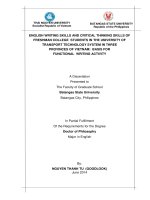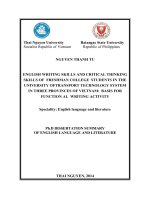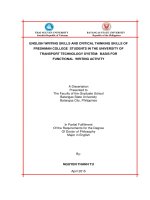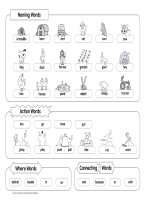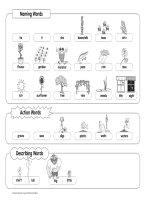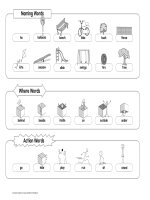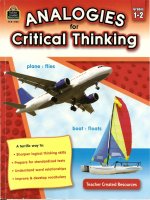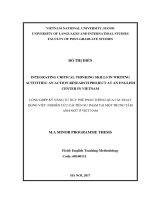Pathways 2 reading writing critical thinking
Bạn đang xem bản rút gọn của tài liệu. Xem và tải ngay bản đầy đủ của tài liệu tại đây (40.96 MB, 244 trang )
Reading,
and
Critical
Laurie Blass
Mari Vargo
Writing,
Thinking
NATIONAL | „
GEOCRAPHIC | £ø eeeHEINLE
CNC
LEARNING
-
Leal a
From the Classroom to the World
We honor the mission and tradition of National Geographic Society: to inspire people to care about the planet.
People you will meet in PATHWAYS
Chef and conservationist
Cultural anthropologist
[CÀ - CC Có
believes the food choices
Michael Wesch
studies how the use of
we make directly affect
the ocean environment.
social media is changing
how we learn and teach,
Author and Researcher
PET Dig
travels in search of the
Oceanographer
longest-lived - and
happiest ~ people on the
I9 <0 <5
Medical Scientist
Hayat Sindi
created a health tool the
Sylvia Earle
has led more than 60
expeditions to explore
marine ervirorimertts.
Tornado chaser
Tim Samaras
tracks violent storms to
that costs just a cent.
discover exactly how and
why they form.
Entrepreneur
Frog expert
size of a postage stamp
dane Chen
and her team developed
a way to help millions
of babies in developing
Counttries.
Technology innovator
Ken Banks
is helping small
businesses succeed
around the world.
Valerie Clark
looks for cures for
diseases from some
of the world’s most
poisonous
creatures.
Engineer and inventor
'Wiliiam
Kamkwamba
built a windmill to power
his vilage when he was
just 14 years old.
PATHWAYS
Laurie
Blass
oN
SEOCRAPHIC
LEARNING
Mari
| =»
Vargo
HEINLE
CENGAGE Learning
Australia « Brazil + Japan + Korea + Mexico + Singapore » Spain + United Kingdom + United States
NATIONAL
+ „ HEINLE
GEOGRAPHIC | #40 CENGAGE Learning
|
Pathways 2
Reading, Writing; and Critical Thinking
© 2013 National Geographic Learning, a part of Cengage Learning
ALL RIGHTS RESERVED. No part of this work covered by the copyright herein
Publisher: Andrew Robinson
Executive Editor: Sean Bermingham
Associate Development Editor: Sarah Tan
graphic, electronic, or mechanical, including but not limited to photocopying,
recording, scanning, digitizing, taping, Web distribution, information networks,
Laurie Blass and Mari Vargo
Contributing Editors: Bernard Seal, Sylvia Bloch
Director of Global Marketing: lan Martin
Marketing Manager: Caitlin Thomas
Marketing Manager: Emily Stewart
Director of Content and Media Production:
Michael Burggren
Senior Content Project Manager: Daisy Sosa
Manufacturing Manager: Marcia Locke
Manufacturing Buyer: Marybeth Hennebury
Associate Manager, Operations:
Leila Hishmeh
Cover Design: Page 2 LLC
Cover Image; Patrick McFeeley/
National Geographic Image Collection
Interior Design: Page 2, LLC
Composition: Page 2, LLC
may be reproduced, transmitted, stored or used in any form or by any means
or information storage and retrieval systems, except as permitted under
Section 107 or 108 of the 1976 United States Copyright Act, without the prior
written permission of the publisher.
==
—
[
For permission to use material from this text or product,
|
|
=
submit all requests online at cengage.com/permissions
Further permissions questions
can be emailed to
permisslonrequestiacengage:com
—
Library of Congress Control Number: 2012932717
Intetinational Stistent Editions
ISBN-13: 978-1-133-31287-1
ISBN-10: 1-133-31287-X
US. Edition:
mm...
mm.
National Geographic Learning
20 Channel Center Street
Boston, MA 02210
USA
Cengage Learning is a leading provider of customized learning solutions with
office locations around the globe, including Singapore, the United Kingdom,
Australia, Mexico, Brazil, and Japan. Locate your local office at:
ngl.cengage.com
Cengage Learning products are represented in Canada by Nelson Education, Ltd.
Visit National Geographic Learning online at ngl.cengage.com
Visit our corporate website at www.cengage.com
Printed in the United States of America
34567815 1413 12
Content =)
Scope and Sequence
1
4
3
4
5
6
7
ts]
=)
1O
Explore a Unit
Happiness
Big Ideas
Connected Lives
Deep Trouble
Memory and Learning
Dangerous Cures
Nature’s Fury
Building Wonders
Form and Function
Mobile Revolution
Video Scripts
Independent Student
Handbook
Vocabulary and Skills Index
4 Tornado Alley in the
4 Chichén Itza in Mexico has been
d one of t!
/en Wondk
finally be complete in 2026—more than
100 years after it began. page
145
A remarkable world
©xists beneath the
waves of Australia’s
Coral Sea.
Madagascar is
"00 j
0/00
Do
page 63.
Unit
Academic Pathways
Vocabulary
1
Lesson A:
Understanding meaning
Happiness
Page
1
Academic Track:
Identifying an author's main id
Gue
meaning from cor
2
Lesson A:
Interdisciplinary
3
Connected
Lives
Page 41
Academic Track:
Anthropology/
Sociology
an everyday context
Understanding a classification text
Lesson C:
Academic Track:
Using new vocabulary in
Lesson B:
Health Science
Big Ideas
Page 21
from context
Introduction to the pa
Writing a topic senter
Lesson B:
Understanding meaning
from context
identifying part of speech
from context
Using new vocabulary in
Lesson C:
Word Link: -tion, -able
Lesson A:
Understanding meaning from
Understanding a biographical text
\dentifying supporting ideas
Ranking ideas in order of priority
Supporting the main idea and
giving details
Writing a descriptive paragraph
Skimming for gist
Making infe
ces
Academic Track:
Interdisciptinary
an everyday context
context
Using new vocabulary in an
everyday context
Lesson B:
Word Link: -inter
Reading a magazine article
al
Word Partners: environmentally
Lesson C:
Writing a concluding sente
Writing « opinion paragraph
Understanding meaning
Lesson A:
Deep Trouble
Page
Word Partners: factor
Interpreting visual inform
Examining problems anc
Lesson B:
from context
tions
Understanding graphic information
Reading an interview
Lesson C:
Us
J New vocabulary in an
eryday context
Word Partners:
informed
sduce,
Word Link: mini-
Explaining
5
Memory and
Learning
Unde
ding meaning
frorn context
Using new vo:
ydi
Word Link: -ize, trans-
Word Partners: s
n an
Reading
Writing
Viewing
Critical Thinking
Interpreting infographics
Goal:
Video:
Inferring word meaning from
Predicting for main idea
Understanding the gist
Identifying key details
Using clues in opening
sentences
Skill Focus:
Writing a paragraph
Grammar:
Using simple present tense
Skill:
Writing a topic sentence
Identifying main ideas
Interpreting survey information
Predicting for main idea
Understanding the gist
identifying key details.
Skill Focus:
Goal:
Writing a descriptive
paragraph
Grammar:
Using simple past tense
Identifying supporting ideas
Skill:
Supporting the main idea and
giving details
Interpreting maps and charts
Goal:
Predicting for main idea
Understanding the gist
Grammar:
Identifying key details
Scanning for key details
Skill Focus:
Skimming for gist
Writing an opinion paragraph
Using present perfect tense
Skil
Writing @ concluding sentence
Interpreting maps
Understanding the gist
Identifying main ideas
Identifying purpose
Identifying key details
Goal:
Skill Focus:
Skill:
Interpreting visual information
Writing a paragraph that
explains a chart or graph
Grammar:
Describing charts and graphs
Explaining a chart or graph
(graph/map)
Longevity Leaders
Guessing meaning
from context
Viewing for general
understanding
Viewing for specific
information
Video:
Solar Cooking
Viewing for general
understanding
Viewing for specific
information
context
Analyzing and discussing
information
Synthesizing information to
identify similarities
CT Focus:
Inferring meaning from context
Identifying problems and
solutions
Synthesizing information to
identify similarities
Analyzing and ranking ideas and
providing reasons
CT Focus:
Deciding on criteria for ranking
Video:
Lamu: Tradition and
Modernity
Guessing meaning fromn
context
Viewing for general
understanding
Viewing for specific
information
Video:
Saving Bluefin Tuna
Viewing to confirm
predictions
Viewing for general
understanding
Viewing for specific
information
Synthesizing information to
identify similarities
Synthesizing information for
group discussion
Analyzing text for function and
purpose
CT Focus:
Making inferences from a text
Inferring word meaning from
context
Evaluating author arguments
Synthesizing textual and visual
information for discussion
Analyzing text for key
information
CT Focus:
Analyzing and evaluating
problerns and solutions
presented in a text
Interpreting infographics
Understanding the gist
Identifying key details
Goal:
Writing a paragraph with
supporting information
Classifying information using
Grammar:
Identifying main ideas
Skill:
a T-chart
Skill Focus:
Identifying cause and effect
Using by + gerund
Using an outline
Video:
Memory School
Viewing to confirm
predictions
Viewing for gerieral
understanding
Viewing for specific
information
Inferring author opinion from
the text
Synthesizing information for
group discussion
Analyzing text for function and
purpose
CT Focus:
Applying a new method for
internalization
SCOPE
AND
SEQUENCE | vii
Scope
and Sequence
Unit
Academic Pathways
6
Lesson A:
Dangerous
Cures
le 101
Academic Track:
Vocabulary
Identifying pros and cons
tifying
figurative langu
Lesson B:
Reading a biog) aphical
Lesson C:
Showing
both
aunt
bulary in an
ntex:
Identifying part of speech from
context
Word Link: cis
sides
of an
isst
Medicine
Writing a persuasive paragraph
Word Partners: relief
7
Lesson A:
Understanding meaning
from context
Using new vocabulary in an
Nature’s Fury
Page
Academic Track:
Earth Science
8
Identifying
expository
Synthesizing information from
multiple
texts
Lesson C:
Form and
Function
Reading a comparison text
Using a Venn diagram t
Va
F
ph
Writing ao mparison paragraph
Word Partners:
Lesson A:
standing meaning
from context
Using
ulary in an
Iishing facts from theori
Lesson B:
nthesizing information fro!
Identifying s
Word Partners: ihe
Academic Track:
Science
Mobile
Revolution
Academic Track:
I, experienc
Word Link: tr:
Page 163
10
Word Partners: 0:
Lesson A:
Lesson C:
9
context
Scanning for specific informatior
Page 141
Anthropology
and Sociology/
Archa
xt
identifying part of speech from
a tim 2 line to plana
raph
Writing a p
$ paragraph
Lesson B:
Academic Track:
everyday ¢
Lesson B:
Building
Wonders
2 in an
ơn an exp‹
ry tex!
Reading
Writing
Comparing text and images
Understanding the gist
Identifying key details
Goal:
Understanding references in
the text
Skill Focus:
Identifying pros and cons
Writing a persuasive paragraph
Grammar:
Making concessions
Skill:
Convincing
Goal:
Understanding the gist
Grammar:
identifying key details
Identifying supporting
examples
process
Identifying main ideas
Skill Focus:
Identifying sequence
a reader that
something is true
Interpreting maps and
captions
Viewing
Writing a process paragraph
Verb forms for describing a
Skill:
Organizing a process
paragraph
Analyzing and relating textual
information
Understanding the gist
Goal:
Identifying supporting details
Using comparative adjectives
Writing a comparison
paragraph
Video:
=,
"
le/Tfog:LIeRar
Viewing to confirm
predictions
Viewing for general
understanding
Viewing for specific
information
Video:
„
Lightning
Viewing to confirm
predictions
Viewing
for general
fowing for a
understanding
Viewing for specific
information
Video:
The Pyramids of Giza
Identifying main ideas
Grammar:
Skill Focus:
Skill:
Identifying and writing about
things you wish to compare
Viewing to confirm
predictions
Viewing for general
understanding
Viewing for specific
information
Interpreting text and images
Goal:
Video:
Scanning for specific
information
Understanding the gist
identifying main ideas
Identifying supporting details
Skill Focus:
Identifying and differentiating
theories from facts
Writing a summary
Grammar:
Using synonyms
Skill:
Explaining key ideas of a
passage in your own words
Flying Reptiles
Using Bitor Knowledge
Mpi:kiB'RitetiRnl
understanding
Viewing for specific
information
al Thinking
Synthesizing information to identify
similarities
Synthesizing inforination for group
discussion
Analyzing aid organizing
information into an outline
Analyzing text for function and
PAHEEEB:
GT Focus:
Identifying figurative language
Synthesizing information to
identify similarities
Analyzing and discussing
connor
Inferring and identifying reasons
CT Focus:
Evaluating sources for reliability
and purpose
Using prior knowledge to reflect
on content
Evaluating arguments
Analyzing information to
complete a Venn diagram
CT Focus:
Identifying and analyzing
similarities and differences (e.g.,
using graphic organizers)
Applying theories to different
|
Synthesizing information to
identify similarities
Analyzing and discussing
|
|
sCenarios
|
/
content
Analyzing text for function and
purpose
CT Focus:
“Evaluating evidence
Interpreting maps, charts,
and captions
Understanding the gist
Identifying main ideas
Identifying sequence
Skill Focus:
Taking notes and using
graphic organizers
Goal:
Writing a problem-solution
paragraph
Grammar:
Using modals to discuss
abilities and possibilities
Skill:
Describing a problem and
suggesting a solution
Video:
‘Synthesizing information to
CA EU SHD” 209 0e)
identify similarities
Analyzing and discussing
predictions
Viewing for general
Identifying problems and
solutions
Viewing to confirm
understanding
ooo
|
||
information
CT Focus:
Relating information to personal
experience
SCOPE
AND
SEQUENCE
| ix
|
Each unit has three lessons.
Lessons A and B develop academic
reading skills and vocabulary by focusing
on two aspects of the unit theme. A
video section acts as a content bridge
between Lessons A and B, The language
and content in these sections provide the
stimulus for a final writing task (Lesson C).
The unit theme focuses on
an academic content area relevant
to students’ lives, such as Health
Science, Business and Technology,
and Environmental Science.
Academic Pathways
highlight the main academic
skills of each lesson.
Exploring
the Theme
provides a visual
introduction to the
unit, Learners are
encouraged to
think critically and
share ideas about
the unit topic.
x | EXPLORE A UNIT
{Lesson A:
‘Lesson8:
Lesson ©:
Interpreting visual information
Examining
prabioms
solutions
Understanding
graphicandInformation
Reading an interview
Expiainng a chart or graph
in Preparing to Read, learners are
introduced to key vocabulary items from the
reading passage. Lessons A and B each present
and practice 10 target vocabulary items.
Reading
A is a single, linear text related
to the unit theme. Each reading passage is
recorded on the audio program.
and other
graphic
formats
WHERE FISH
ARE CAUGHT
help to develop
learners’ visual
literacy.
Guided comprehension tasks
and reading strategy instruction
enable learners to improve their academic
literacy and critical thinking skills.
|| Understanding
ha Ginoya ann ren
Don pr 6 Wes oH pesto cmc
touts nm andr ase cape 88-860
EXPLORE A UNIT
| xi
Viewing tasks related
to an authentic National
Before Viewing.
A Une Denny. a vr unt re
ƒ———..`..a
ng
nauotonm sat atc nos spa:
{Hons bei
Geographic video
serve as a contentbridge between
Lessons A and B.
(Video scripts are on
pages 203-208.)
i le
After Viewing.
(BBA) Decues anenere to he questons Tad stove witha perme,
© (comer
oe
riating eins Aig pha aienca
Learners need to use their critical thinking
skills to relate video content to information in
the previous reading.
Word Link and Word Partners boxes
An Interview with Barton Seaver
Barton Seaver isa chef and conservationist! who wants our help
to save the oceans. He believes that the choices we make for dinner
hhave a direct impact on the ocean’s health. According to Seaver,
inividoals ean make a big difference by making informed choices,
Q, Should people stop eating senfood?
People should definitely not stop eating seafood altogether. There are
certain species that have been severely overfished and that people should
avoid for environmental reasons. But I believe that we can save the oceans
while continuing to enjoy seafood, For example, some types of seafood,
such as Alaskan salmon, come from well-managed fisheries. And others,
stich as farmed mussels and oysters, actually help to restore declining wild
populations and clean up polluted waters.
Q, What kind of seafood should people eat?
develop learners’ awareness of word structure,
collocations, and usage.
What should they not cat?
‘My general advice is to eat fish and shellfish that are low on the food
chain and that can be harvested? with minimal impact on the environment.
‘Some examples include farmed mussels, clams and oysters, anchovies,
sardines, and herring, People should not eat the bigger fish of the sea, like
tuna, orange roughy, shark, sturgeon, and swordfish.
Q, Why did you choose to dedicate? your life to the ocean?
believe that the nest great advance in human knowledge will come not
from new discoveries, but rather from learning how we relate to our natural
‘world, Humans are an essential part of nature, yet humans do not have
1 very strong relationship with the world around them. I have dedicated
myself to helping people to understand our place on this planet through the
foods thar we eat
Guided pre-reading tasks and strategy
tips encourage learners to think critically about
what they are going to read.
128 © | ranting Ne sons to hes acon aoa ip sso ho esi hth
sp th “Đá wit: dectining pepatations
TC
TT...
xii | EXPLORE A UNIT
7
Q, Why do you believe people should care about the
health of the oceans?
‘The health of the oceans is directly linked to the health of people, The
ocean provides most of the air we breathe. It has a big effect on the weather
that we rely on for erops and food production. It also provides a necessary
and vital* diet for billions of people on the planet. So T don’t usually say that
Tam trying to save the oceans. I prefer to say that Tam trying to save the
vital things that we rely on the ocean for:
72) units
+ A conservationist is someon who works to protec the envroemant.
+ \imen you harvest something, such asa crop or other type of food,
you gather tin
+ Vinan you dedicate yoursel te something, you gv ta lt of ime and
for because you think tis important,
‘Something that is vitals very
LESSON
L3. Bhông pou orange rug lắc không -ỉ
SS
tasks require
Lesson B’s
Ð | Critical Thinking: Analyzing Problems an Solutions, Fx osc cb
learners to analyze,
reading passage
on or
synthesize, and
presents a further
critically evaluate
aspect of the unit
theme, using a variety of
text types and graphic
in each reading.
se wb
ela, le
at mort he oho
Suggestions
J"——-..
ideas and information
Teopl da’ hate
a Seong
feline wth the mười,
round them,
{REE | Crileal Thinking: Synthesizing. Discuss the questonsin
smal gruns.
1 ‘Bete ene cored
tha reo cae male ih; How can ti el the
scan conn?
2 Doyo ase wth Sener tht “ni
do ot ae ery rong ns wth te
vad bon Wh ae sot rani ut ro aa Ne?
HERBIVORES
10 pounds ainsistn
A pound
‘ts tke eating ..
emma
oe
hat We
Makes
of Bon Sars apes
Problems
formats.
it
————sdwdng,
ete
—————————=
A Wate a i
Critical thinking
B
a
PLANTS
«1,000 pounds
3100 pounds
—_
Authentic
ig de
noe
A top predator needs much more food to survive than fish at lower levels of the
food chain do. When we catch or eat top predator, we increase our impact onthe ocean.
.
sa
.
graphics
from National
Geographic
support the
main text,
helping learners
comprehend
P.1.
Cee
`
o
Examples
of camivores include squid
ee
Predators.
es
a
le iny anim:
ae
en
and clarms,
lieh sụch ag shfimp
KT
EXPLORE
A UNIT
| xiii
Integrated grammar
The Goal of LessonC
s for learners to relate their
practice and writing
‘skill development
—
provides scaffolding for the
own views and experience
writing assignment.
to the theme of the unit by
completing a guided writing
assignment.
The Independent
Student Handbook
provides further language
support and self-study
strategies for independent
learning.
» see pages 209-217.
Video DVD with
authentic National
Teacher's Guide
ĩ
}
PATHWA’
Geographic clips relating
†o each of the 10 units.
it
PATHWAYS
Teacher’s Guide
including teacher's notes,
expansion activities, rubrics
for evaluating written
| EXPLORE A UNIT
assignments, and answer
Audio CDs with audio
keys for activities in the
recordings of the Student Book
Student Book
reading passages.
1
A guided process approach develops learners’ confidence
in planning, drafting, revising, and editing their written work.
Unit Quiz provides an opportunity
for learners to review some of the key
ideas and language from the unit.
Assessment
CD-ROM with
ExamVier
Online Workbook, powered by MyELT,
with both teacher-led and self-study options.
This contains the 10 National Geographic
containing a bank
video clips, supported by interactive,
automatically graded activities that practice
the skills learned in the Student Books.
of ready-made
questions for
quick and effective
assessment.
'PRESENTATION TOOL.
D3 SƠ)
ArioN T@0L.
220M
Classroom Presentation Tool
CD-ROM featuring audio and video
clips, and interactive activities from the
Student Book. These can be used
with an interactive whiteboard or
computer projector.
EXPLORE A UNIT
| xv
Text
4-5, 12-13: Adapted from “Thrive: Finding Happiness the Blue Zones Way,” by Dan Buettner: National Geographic Books, 2011,
25-26: Adapted from “Windmills of His Mind,” by Karen Lange: _central/2009/10/the-windmills-of-hismind.html, October 2009, 32-83: Adapted from "Big Ideas, Little Packages": NGM November 2010, and “Hayat Sindi”: http://
www.nationalgeographic.com/explorers/bios/hayat-sindi/, 45-46: Adapted from “Michael Wesch’: ionalgeographic.
comexplorers/bios/michae!-wesch/, 52-58: Adapted from “Welcome to Internet Island,” by James Viahos: National Geographic
‘Adventure, February 2007, 65-66: Adapted from “Overfishing’: 72-73: Adapted from “Seafood Crisis,” by Paul Greenberg: NGM October 2010, 85-86: Adapted from “Remember This,”
by Joshua Foer: NGM November 2007, 92: Adapted from “Memory Boosters: How to Help": NGM November 2007, 98: Adapted from
“Direct Evidence of the Role of Sleep in Memory Formation Uncovered,” by David Braun: />news/chiefeditor/2009/09/sleep-and-memory.html, 105-106: Adapted from “Zoltan Takacs”: httpy/www.nationalgeographic.com/
explorers/bios/zoltan-takacs/, 112-113: Adapted from “Pick Your Poison,” by Cathy Newman: NGM May 2005, 125-126: Adapted
from “Joplin, Missouri, Tornado Strong, But Not Surprising?" and “Monster Alabama Tornado Spawned by Rare “Perfect Storm"” by
Willie Drye: http:/news.nationalgeographic.com/news/2011/05/110523-joplin-missouri-tornado-science-nation-weather/ and http://
news.nationalgeographic.com/news/2011/04/110428-tuscaloosa-birmingham-alabama-news-tornadoes-science-nation/,
132-133: Adapted from “Fire Season,” by Neil Shea: NGM July 2008, 145-148: Adapted from “Gaudi's Masterpiece,” by Jeremy
Berlin: NGM December 2010, 154: Adapted from “The Birth of Religion,” by Charles C. Mann: NGM June 2011,
155: Adapted from “Chichén Itza": 167-168: Adapted
from “Evolution of Feathers,” by Carl Zimmer: NGM February 2011, 174: Adapted from “Power Beak,” by John Eliot: NGM June
2008, 175: Adapted from "Beetles Shell Offers Clues to Harvesting Water,” by Bijal P. Trivedi: />news/2001/11/1101_TVdesertbeetle.htmi, and “How Shark Scales Give the Predators Deadly Speed,” by Christine DellAmore:
187-188: Adapted from
“Ken Banks”: and “How To Change the World”: http:/newswatch.
nationalgeographic.com/2010/10/22/how_te_change_the_world_poptec/ 194-195: Adapted from “Newswatch: Mobile Message”:
and "Aydogan Ozcan": http:/www.nationalgeographic.com/
explorers/bios/aydogan-ozcan/
NGM = National Geographic Magazine
Photo Images
Cover: Patrick McFeeley/National Geographic, IFC: Katie Stoops, IFC: Michael Wesch, IFC: Courtesy of Dan Buettner,
IFC: Tyrone Turner/National Geographic, IFC: Kris Krug, IFC: Jim Webb, IFC: Embrace Global, IFC: Rebecca Hale/National
Geographic, IFC: Bedford, James/National Geographic Stock, IFC: Moving Windmills Project, Inc., I: Wes. C. Skiles/National
Geographic, ili: Steve Raymer/National Geographic, ili Ken Eward/National Geographic Stock, ill: Lynsey Addario/National
Geographic, iii: David Doubilet/National Geographic, its Gerd Ludwig/National Geographic Stock, ili: Bruce Dale/National
Geographic Image Collection, ilit Mark Thiessen/National Geographic, ili: Simon Norfolk/National Geographic, ili: Joe Petersburger/
National Geographic, ili: Ken Banks, kiwanja.net, iv: Campo, Colorado/National Geographic, iv: Simon Norfolk/National Geographic,
iv: Stephen Chao/National Geographic, iv: Frans Lanting/National Geographic, iv-v: NASA Goddard Space Flight Center Image
by Reto Stéokii (land surface, shallow water, clouds), v: ©2011/Vincent J. Musi/National Geographic Image Collection, v: Steve
Raymer/National Geographic, v: David McLain/National Geographic, v: Ben Keene, v: David Doubilet/National Geographic, v: Joel
Sartore/National Geographic, viz Michael S. Lewis/National Geographic, vi: Moving Windmills Project, Inc., vi: Bobby Haas/National
Geographio, vi: Brian J. Skerry/National Geographic, vi: Anne Keiset/National Geographic, vi i: Bruce Dale/National Geographic
Image Collection, vili: Mike Theiss / National Geographic, vi i:
National Geographic, viii: Robert Clark/National Geographic,
viii: Guillaume Collanges, 1: Joel Sartore/National Geographic, 2-8: Steve Raymer/National Geographic, §: Steve Raymer/National
Geographic, 6: Michael S. Lewis/National Geographic, 8: Stephen St. John/National Geographic, 9: David McLain/National
Geographic Stock, 12: Sisse Brimberg/National Geographic, 12: David McLain/National Geographic, 12: Lynsey Addario/National
Geographic, 13: Image courtesy of Dan Buettner, 24: Ken Eward/National Geographic Stock, 22: Ira Block/National Geographic,
23: Wright, Orville/National Geographic, 23: Paul Sutherland/National Geographic, 25: Workshop Loves You, 26: Moving Windmills
Project, Inc., 26: The Toronto Star/ZUMApress.com, 27: Workshop Loves You, 28: SuperStock/Corbis, 29: Rebecca Hale/National
Geographic, 29: Jodi Cobb/National Geographic, 30: Michael Melford/National Geographic Image Collection, 32: Embrace Global,
32: Rebecca Hale/National Geographic, 32: Renee Comet/National Geographic, 38: Renee Comet/National Geographic, 33: Kris
Krug, 33: Renee Comet/National Geographic, 41: Susan Seubert/National Geographio, 43: Lynsey Addario/National Geographic,
45: Gerd Ludwig/National Geographic, 46: Peter Essick/National Geographic, 46: Michael Wesch, 49: Bobby Haas/National
Geographic, 50: Ben Keene, 52: James Vlahos, 52: Ben Keene, 53: James Viahos, 5: James Viahos,
xvi
CREDITS
continued on p. 224
»
ˆ
ACADEMIC PATHWAYS
Lesson A:
Lesson B:
Lesson
Identifying an author’s main ideas
Guessing meaning from context
Understanding a classification text
Introduction to the paragraph
Writing a topic sentence
Think and
Discuss
1. What does it mean to be happy?
2. Think of someone you know who seems happy.
How do you know he or she is happy?
Describe the person.
a A zebra butterfly brings joy to a young girl in Lincoln, Nebraska.
Look at the information about two surveys and discuss the questions.
1. Where are the happiest places on Earth, according to the two survey
How do the results compare?
2. Why do you think people from
these countries are happy?
8. Imagine you want to find the happiest place in your country. What
information would you look at? What questions would you ask?
World Happiness Survey @)
Happy Hot Spots
The World Database of Happiness brings together scientific reports on
happiness from 149 countries around the world. The researchers ask people
to rate their enjoyment of life on a scale from 0 to 10. The top six happiest
nations according to the survey (2000-2009) are listed below. The happiest
Asian country, Singapore, is 37th in the list; Malawi (62nd) is Africa’s happiest
nation. The world’s richest nation, the United States, placed 21st.
©
Iceland
|
Ỉ
Rating
8.2
Pop.: 311,000
GDP po: $38,300
Avg. Life: 80.9 years
8
+
Finland
Rating 7.9
Pop 5.3 million
GDP po: $35,400
Avg. Life: 79.27 years
2)
e
mm
I+] Mexico
Rating
Rating 7.9
GDP pe: $36,600
Avg.
sa Costa Rica
Rating 8.5
.
Pop.: 4.6 million
GDP pe: $11,300
Avg. Life: 77.72 years
ae
8.3
Pop.: 5.5 million
Pop. 113.7 million
GDP pe: $13,900
Avg. Life: 76.47 years
Ỉ
Denmark
Life: 78.63 years
El switzerland
Pop.: Population; GDP pe: Gross
Domestic Product per capita
(the value of goods and services
produced by a country, divided by
Rating 8.0
Pop.: 7.6 million
GDP pe: $42,600
Avg. Life: 81.07 years
the number of people); Avg. Life:
Average life expectancy.
Source: nl/
2
|
UNIT1
R
;
World Happiness Survey (2)
Happy Planet
The Happy Planet Index was started in
2006 by the New Economics Foundation
(NEF). It measures average personal
happiness together with a country’s average
life expectancy and environmental impact.
The highest-rated countries have happy,
long-living people without harming the
environment.
The top six countries in the 2009 Index.
are listed below. Other countries in the top
20 include Brazil (9th), Egypt (12th), Saudi
Arabia (13th), the Philippines (14th), Argentina
(1&th), and China (20th).
1 Costa Rica
=m
2 Dominican Republic
3 Jamaica
BE
4 Guatemala
4 An elderly Vietnamese
woman smiles for a
photo.
Vietnam was
rated #5 in the 2009
Happy Planet Index,
the highest-placed Asian
nation in that survey.
HAPPINESS
| 3
A
| Building Vocabulary. Find the words in blue in the reading passage on pages 5-6. Read
the words around them and try to guess their meanings. Then write the correct word or
phrase from the box to complete each sentence (1-10).
access
basicnecessities
confident
financial
freedom
poverty
provides
secure
socialize
standard of living
1. When you ___________________, you spend time with other people for fun.
2. A country with a lot of —_____________
have money.
has a lot of people who don’t
3.
Ifyou have ________
4.
Ifyou have complete
5.
Ifa government ____________jobs
6.
Ifyou have a high —____.___,
you are very comfortable and wealthy.
7.
Ifyou discuss your ______________
situation, you are talking about money.
8.
9.
10.
Ifyou are __________,
about anything.
to something, you can use it.
„you can do anything you want to do.
you feel safe and are not worried
Ifyou have the _____________,
food to eat.
Ifyouare_
TT
to people, it gives jobs to people.
you have a home and enough
about something, you are sure about it.
Using Vocabulary. Answer the questions. Share your ideas with a partner.
1.
What do you think are the basic necessities in life, besides food and a home?
2.
Do you feel confident about your future? Why, or why not?
3. Who do you socialize with?
Brainstorming. List six things you think a person needs in order to be happy. Share your
ideas with a partner.
Strategy
Predicting. Read the title and the subheads of the
reading passage on pages 5-6. What do you think
i passage isi about? ?
the reading
"tífGfEEes Vol toa
use a dictionary to find other
a. Different things make different people happy.
4
LUNIT1
b. Security is the most important thing for happiness.
forms of a word, €.9., (ad).)
confident, (n.) confidence;
c.
(n.) freedom, (adj.) free; (v.)
Everyone needs the same basic things to be happy.
7
{adj.) secure, (n.) security;
socialize, (adj) social;
(adj.) financial, (n.) finance.
%
4 Ahappy street seller shows off his fruit selection at an open-air market in Singapore.
>|
track 1-01,
'WHAT MAKES US HAPPY Money? Friends? A good job? Are the answers the same
for everyone? According to world surveys, Mexico and Singapore are two happy
countries—but their people may be happy for different reasons.
Safety and Security
There are more than 19,000 people per square mile’ in the small nation of Singapore. People on
the island work an average of 70 hours per week. The country has strict laws, for example, against
littering,” graffiti,? and even for not flushing a toilet. But according to the World Database of
Happiness, Singapore is the happiest country in Asia. Why?
One reason for Singapore’s happiness is that the government provides the basic necessities,
such as jobs and housing. There is almost no poyerty, and Singapore has one of the lowest levels of
unemployment in the world. The government creates jobs for people who are unemployed. It “tops
up”™ poorer people’s income so everyone can have a minimum standard of living. The government
also offers tax breaks® to people who look after their aging parents. This may be why 84 percent of
older people live with their children. The result is a lot of closely connected families with roughly
equal standards of living.
`
People may not all be happy about the laws, but they are generally happy with the results—they
don’t step in litter, the public toilets work, and the streets are safe and clean. So for Singaporeans,
it seems that living in a secure, clean, and safe place may be more important than having a lot of
personal freedom. As Dr. Tan Ern Ser of Singapore’s Institute of Policy Studies explains, “If you are
hopeful and confident of getting what you want in life, then you are happy.”
+ A square mile = 2.59 square kilometers
“Ifyou top something up, you add to it to make it ful
2 Littering is leaving garbage or trash lying around outside, _® If the government gives someone a tax break, it
® Graffiti is words or pictures that are written or drawn on
lowers the amount of tax they have to pay.
walls or other public places.
HAPPINESS
| 5
LESSON
A
READING
Friends and Neighbors
In many ways, Mexico is the opposite of Singapore. There are some parts of Mexico where
people do not have a safe or secure life. Many people do not have jobs, enough food, or access to
education. But, as in Singapore, most people in Mexico feel that they are happy. Why?
One reason is the
importance of socializing.
According to psychologists,
much of our happiness
comes from remembering
the small joys that happen
throughout the day. Simple
acts of socializing, such as
talking with a neighbor or
having dinner with friends,
can greatly increase our
overall happiness. People
in Mexico socialize with
family and friends a lot,
and this adds to their
happiness.
But what about
poverty? In Mexico, about
half of the population
is poor. However, most
people in Mexico live near
« About 60 percent of Mexico's population rates itself as “very happy”—
about 24 percent more than Mexico's richer neighbor, the United States.
people in a similar financial
situation. If your neighbor doesn’t have expensive items, such as a big house or an expensive car,
you don’t feel the need to have those things. So money, by itself, may not beso important for
happiness. What matters more is how much money you have compared to the people around you.
A Mixed Recipe?
So the question “What makes people happy?” does not seem to have a simple answer. Work,
security, safety, freedom, and socializing with friends and family can all play important roles. As
the examples of Singapore and Mexico suggest, there may be no single recipe for happiness. The
good news is that we can each find our own.
ú
‘Adapted from Thrive: Finding Happiness the Blue Zones Way by Dan Buettner, 2010
6
| UNIT4
A
| Understanding the Gist. Look back at your answer for exercise D on p. 4.
Was your prediction correct?
| Identifying Key Details. Match each statement (1-7)
to the place it describes, according to the reading.
N
Qa
PON
=
B
C
Most people here feel that they are happy.
Most people have equal standards of living.
The government provides the basic necessities.
Family is important to people.
People spend a lot of time with family.
People feel safe and secure.
Although many people are poor, most of them are happy.
| Critical Thinking: Guessing Meaning from Context. Find and underline these
bold words in the reading on page 5. Use context to identify their meaning. Then
match the sentence halves to make
1,
definitions.
—__ Ifyou are strict,
2. __ Ifyou are flushing something,
3, __ Ifyou are unemployed,
4, __ Ifyou look after people,
5. —— Ifyou make something public,
aD
bea
Use the
context—the
a. you provide it to everyone.
words around a
b. you take care of them and make
word—to guess
sute they are well.
the meaning
of a word you
c. you don’t allow people to
behave badly.
don't know. The
context can also
d. you do not have a job.
help you decide
the word's part
@. you are cleaning or emptying it
with a fast flow of water.
adjective, eto.
of speech, e.g.,
noun, verb,
| Critical Thinking: Analyzing. Discuss your answers to these questions with a partner.
1.
Most people in Singapore have financial security and many people in Mexico do not.
In what way is their financial situation similar?
2. According to the author, socializing can make people happy. What examples does he
give? Do you agree with his view?
E
4
| Personalizing. Complete the sentences with your own ideas.
1.
I think (Safety and security/ personal freedom / socializing) is most important
for happiness.
2.
T usually socialize about —__
about —__________________ hours a week.
hours a week, and I (work/ study)
3.
I think I would prefer to live in (Singapore/ Mexico) because
HAPPINESS
| 7
